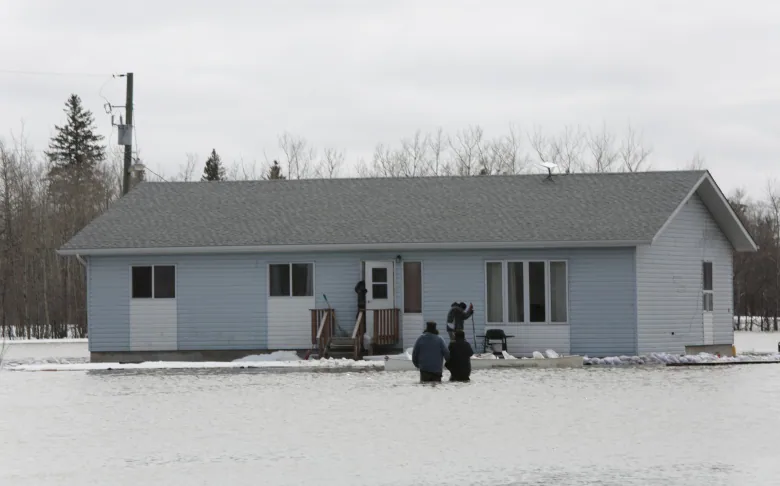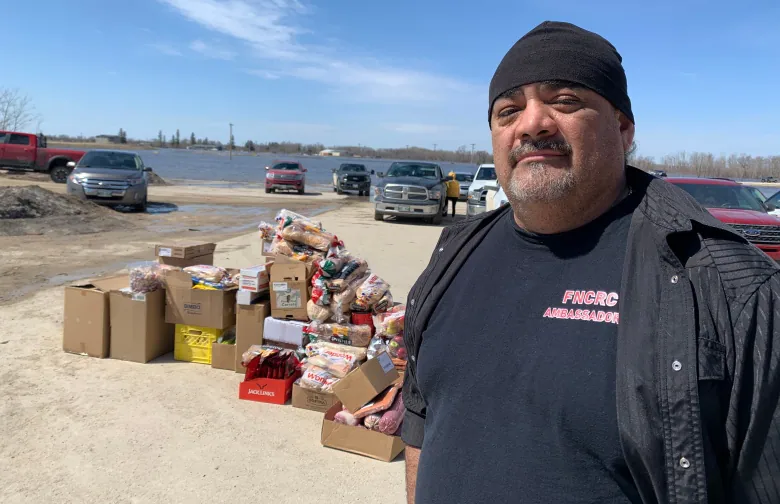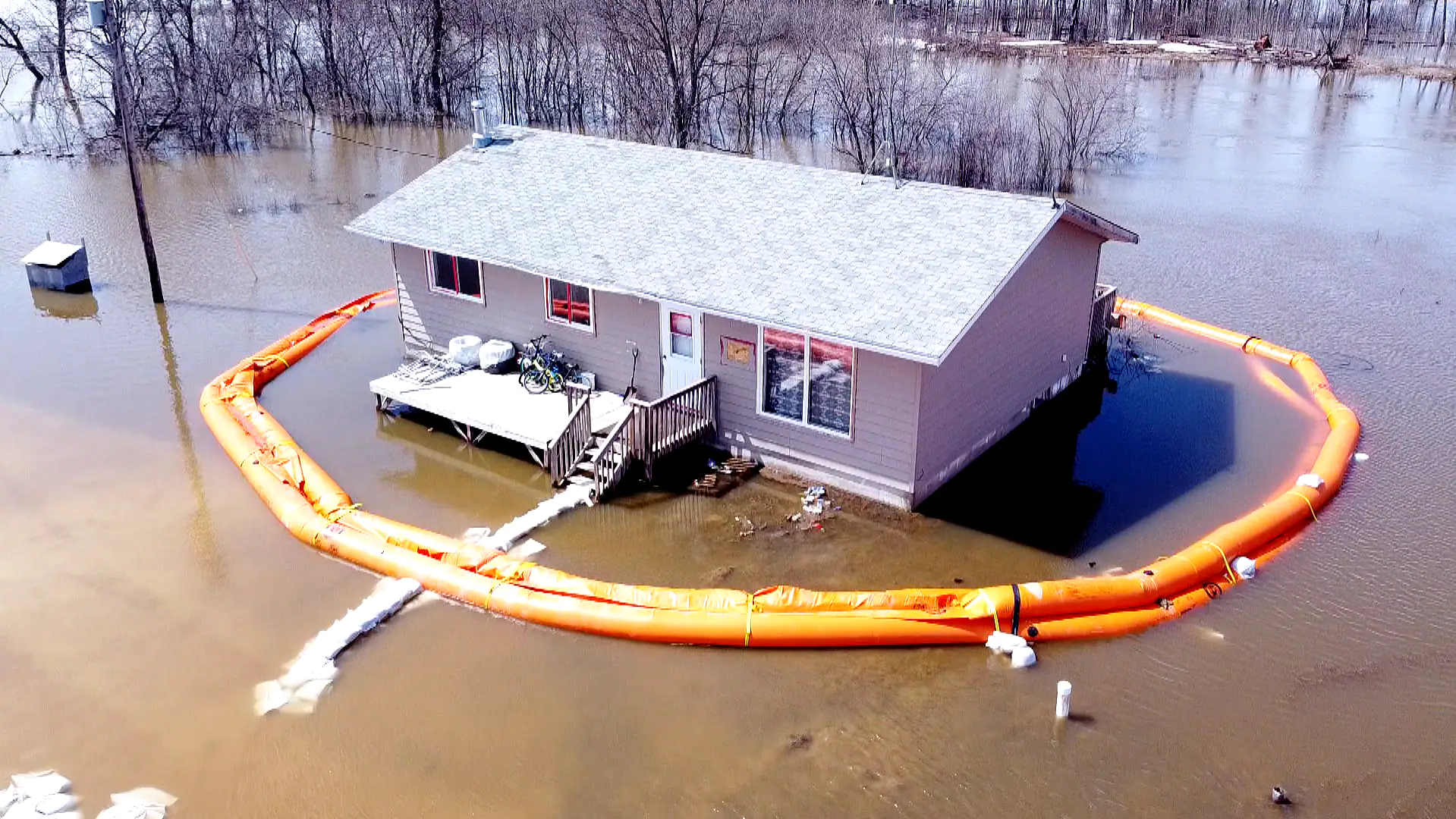As floodwaters chase residents out of Peguis First Nation, a platoon of volunteers is moving in to help in any way possible.
Indigenous Services Canada has recruited 75 volunteers, or ambassadors as the federal agency calls them, to support the Manitoba First Nation’s request for support in sandbagging, delivering groceries and other tasks as needed.
Chief Glenn Hudson has called on the military to come in and help the community, about 160 kilometres north of Winnipeg, but ISC has not yet acted on that.
Instead, it announced on Wednesday that 75 ambassadors from the First Nation Community Response Corp., a group headed by former Bear Clan Patrol director James Favel, is headed to Peguis along with 25 more from the Assembly of Manitoba Chiefs.
Drone footage from the community shows water breaching tiger dams in Peguis First Nation on Monday afternoon. 0:54
“We wanted military assistance but this was being offered so we we decided to go with that. I think if the water continues to rise, then I think the military should come in. But again, that’s something that we’re waiting on a response for,” Hudson said.
“This is the largest probably flooding that we’ve ever had and that most number of impacted homes, so we need more people to help with those efforts.”
Well over 700 homes are impacted by the floodwater, with more than 200 of those almost completely surrounded, Hudson said, noting that in past floods, a maximum of 34 homes were affected.

Nearly 1,400 people have been forced out of the Interlake community, many of them now staying in hotels in Winnipeg.
The largest First Nation community in Manitoba, Peguis has 3,521 members who live on reserve and 6,504 who are off-reserve members.
Harrison Anderson, a Pinaymootang First Nation resident now living in Winnipeg, said he signed up with the First Nation Community Response Corp. to help “because, as you can see, it’s pretty severe out here.”
“I’ve actually never done sandbagging but this community really needs it so it’s definitely good to be here,” he said after getting off the bus in Peguis on Wednesday.

Anderson is part of a group of 45 volunteers from FNCRC to arrive early Wednesday afternoon in Peguis. Another 20 were expected later in the afternoon and another 10 on Thursday, Favel says.
The entire response was mobilized in less than 24 hours after Favel says he was contacted Tuesday by ISC.
“There’s a lot of support for this activity,” he said, adding even more people with FNCRC are in Winnipeg helping the evacuees.
“It’s heartbreaking to see what’s going on,” Favel said about the flooding, noting Peguis is his home community. “I’ve got a lot of family members that are displaced.”
The FNCRC has a five-day mandate to help out, “but it could extend depending on how things are going,” he said.
A spokesperson with ISC said in an email to The Canadian News that its emergency management team is also working with the province of Manitoba to send 25 pumps to Peguis as well as money for other supplies, including additional pumps, trucks and trailers, light power generator and food and water.
Long-term protection needed: Hudson
Peguis has been impacted by flooding many times over the past decade, and Hudson wants to see the community receive permanent protection, not just reactive measures from the federal government.
According to a 2103 report from Aboriginal Affairs and Northern Development Canada (since replaced by two new departments: Crown-Indigenous Relations and Northern Affairs; and Indigenous Services Canada), the federal government has “invested more than $4 million” in Peguis First Nation for long-term flood-proofing as part of a 2010 commitment.”
Not true, Hudson said on Wednesday.

“That’s not the case,” he said. “It’s always been recovery money. There hasn’t been a dollar toward prevention in terms of putting up diking, et cetera,” he said.
The only protection the community has been given is temporary sandbagging, he said.
“Long-term protection? It hasn’t been provided, and that’s why I’ve been stating our community and our people deserve the same thing that Winnipeggers receive,” Hudson said.
“Same thing in southern Manitoba — they’ve put in all kinds of infrastructure. The town of Morris has a ring dike around it. You don’t see any ring dike around here, and that’s what protection is all about. It’s not about sandbagging.”
The community did use some of the money in the past to build ring dikes around three homes, but that does little to help at times like this, he said.
“In this case, we’re talking 200-plus homes that are impacted. They haven’t given enough money to ring dike 200-plus homes or ring dike a community like other cities.”
He estimates that would cost about $90 million. Another option would be to create a floodway diversion like Winnipeg’s around the community, Hudson said.
“We priced that out at, I think it was $50 million, to do that.”
As floodwaters chase residents out of Peguis First Nation, a platoon of volunteers is moving in to help in any way possible. Indigenous Services Canada has recruited 75 volunteers, or ambassadors as the federal agency calls them, to support the Manitoba First Nation’s request for support in sandbagging, delivering groceries and other tasks as needed. 2:12
Reference-www.cbc.ca

